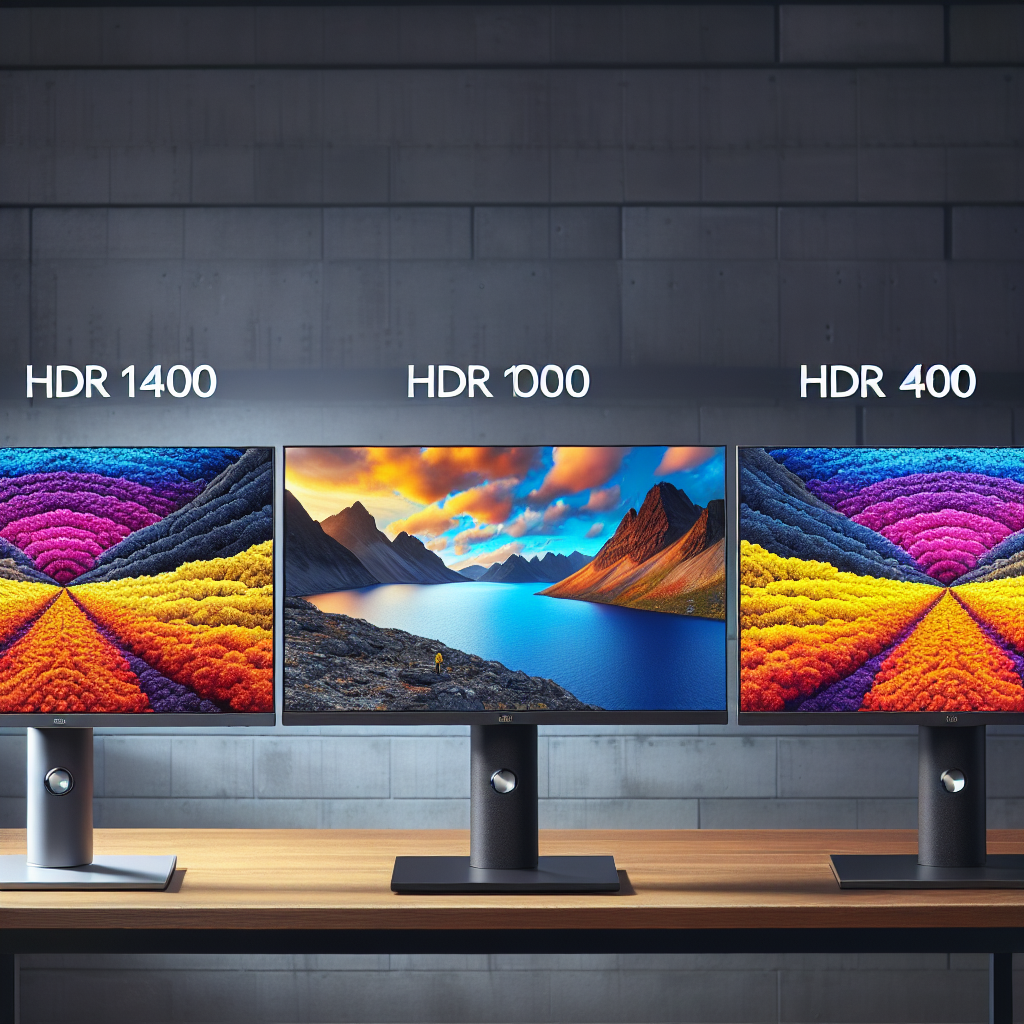High Dynamic Range (HDR) technology has revolutionized the display industry by enhancing the visual experience with better brightness, contrast, and color accuracy. Among the various HDR standards, HDR 400, HDR 1000, and HDR 1400 are commonly discussed. Understanding the differences between these standards is crucial for making informed choices, whether for gaming, professional use, or general consumption.
Key Differences Between HDR 400, HDR 1000, and HDR 1400
Below is a comparison table that summarizes the key differences between HDR 400, HDR 1000, and HDR 1400 monitors:
| Feature | HDR 400 | HDR 1000 | HDR 1400 |
|---|---|---|---|
| Peak Brightness (cd/m2) | 400 | 1000 | 1400 |
| Contrast Ratio | Varies, typically no minimum | 20,000:1 (with local dimming) | 50,000:1 (with local dimming) |
| Color Gamut | 95% sRGB | 90% DCI-P3 | 99% DCI-P3 |
| Bit Depth | 8-bit + FRC | 10-bit | 10-bit |
| Local Dimming | Optional | Required | Advanced Local Dimming |
Peak Brightness
The most obvious difference between these standards is the peak brightness. HDR 400 supports a maximum brightness of 400 cd/m2, while HDR 1000 and HDR 1400 support 1000 cd/m2 and 1400 cd/m2 respectively. Higher peak brightness allows for more brilliant highlights and better handling of bright scenes.
Contrast Ratio
Contrast ratio is another crucial factor. While HDR 400 does not mandate a specific contrast ratio, HDR 1000 and HDR 1400 come with much higher contrast ratios, often achieved with advanced local dimming technologies. HDR 1000 generally ensures a contrast ratio of 20,000:1 or higher, whereas HDR 1400 goes beyond, often exceeding 50,000:1. This higher contrast ratio helps in rendering deeper blacks and more detailed hues.
Color Gamut
Color accuracy and range also vary significantly across these standards. HDR 400 typically covers about 95% of the sRGB color space. On the other hand, HDR 1000 covers around 90% of the DCI-P3 color gamut, providing a wider range of colors. HDR 1400 goes further by covering about 99% of the DCI-P3 color gamut, offering much richer and lifelike colors.
Bit Depth
HDR 400 generally uses 8-bit color depth enhanced with Frame Rate Control (FRC) to simulate 10-bit depth. However, HDR 1000 and HDR 1400 monitors typically offer true 10-bit color depth. This results in smoother color gradients and reduces banding issues, greatly enhancing the overall visual experience.
Local Dimming
Local dimming technology is crucial for enhancing both brightness and contrast. While HDR 400 may have optional local dimming, HDR 1000 and HDR 1400 require this feature. HDR 1400, in particular, uses more advanced local dimming techniques, providing precise control over brightness and contrast to deliver the best possible HDR experience.
Applications and Use Cases
Understanding these differences helps determine which HDR standard is best suited for specific applications:
- Gaming: For gamers, HDR 1000 or HDR 1400 monitors are ideal, thanks to higher brightness and better contrast, which result in more immersive and detailed visuals.
- Professional Work: For graphic designers, video editors, or photographers, HDR 1400 monitors offer superior color accuracy and range, making them more suitable for professional work where color precision is crucial.
- General Use: For general media consumption, HDR 400 monitors provide a noticeable improvement over SDR (Standard Dynamic Range), making them suitable for casual users who do not require the high performance of HDR 1000 or 1400.
Cost Implications
As the features improve, so does the cost. HDR 1400 monitors are generally more expensive due to their superior brightness, contrast, and color accuracy. HDR 1000 monitors fall in the mid-range, providing a balance between performance and cost. HDR 400 monitors are more budget-friendly and serve as an entry point to HDR technology.
Future Trends
The evolution of HDR technology is ongoing, with newer standards and improvements continually being developed. HDR 1400 is currently among the highest standards available, but the industry is moving towards even higher brightness levels, better contrast ratios, and broader color gamuts. Keeping an eye on these trends can help you stay ahead in choosing the best monitor for your needs.
Conclusion
The choice between HDR 400, HDR 1000, and HDR 1400 depends largely on your specific needs and budget. HDR 1400 offers the best overall experience but comes at a higher cost. HDR 1000 provides a balanced option with significant improvements over HDR 400. Ultimately, understanding these differences will help you make an informed decision and get the best value for your investment.
Whether you’re a gamer, a professional, or just someone who appreciates good picture quality, knowing what each HDR standard offers will ensure you choose the right monitor for your needs.

